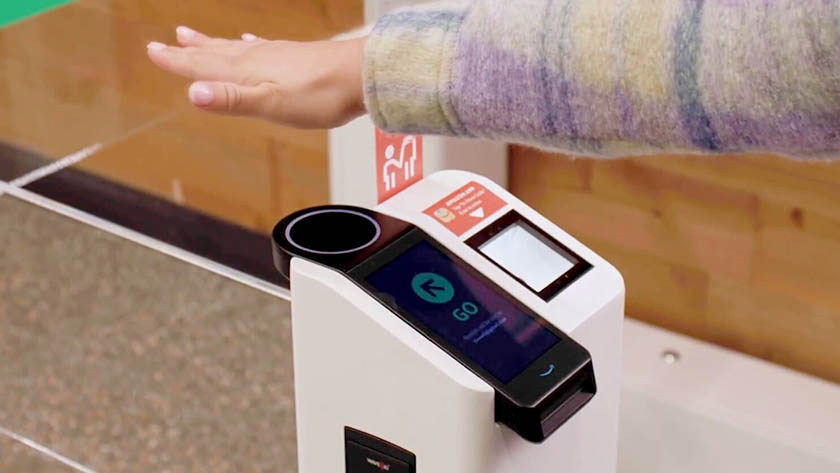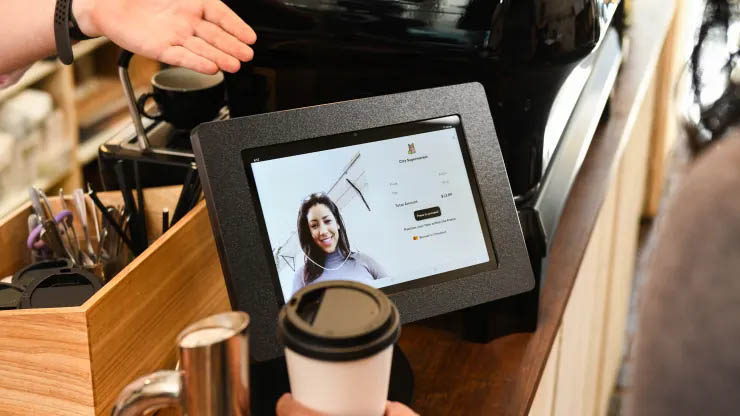Biometric payment involves using unique physical or behavioral attributes, like fingerprints or facial recognition, to authenticate transactions securely. There has been increased adoption of biometric payment in recent years because it is generally considered more secure than password- or PIN-based systems. Biometric payment may be used for in-person and online transactions.
According to a recent study, the global biometric payment market size in 2023 is $39.38 billion, and this is expected to grow by 8.8% in 2024. With the potential of biometric authentication for enhancing security and streamlining payment processes, businesses will benefit from proactively adopting these technologies by investing in and integrating biometric payment solutions.
Key Takeaways:
- Biometric payment is the use of biometric technology, such as scanning unique physical attributes, to authenticate payment transactions.
- There is increased adoption of biometric payment technology because of its ability to enhance security, streamline transactions, and improve the overall customer experience.
- When making a biometric payment, the customer needs to authenticate their identity by scanning their fingerprint, palm, face, or iris.
- Fingerprint authentication is the most common form of biometric payment authentication method.
Biometric Payment Authentication Methods
There are different ways to authenticate transactions with the use of biometrics. Here are some of the current technologies used for biometric payment authentication:
Fingerprint Authentication
Fingerprint authentication stands as one of the most widely adopted biometric methods. It relies on the distinct ridges and valleys of an individual’s fingerprint to create a unique identifier. This method is not only secure but also convenient, as fingerprints are easily accessible and offer a quick means of verification.
The use of fingerprint authentication has skyrocketed among mobile phones, tablets, and other handheld devices. Aside from using fingerprints to unlock and control access to these devices, it is commonly used for authorizing mobile payments. Popular mobile payment platforms, such as Apple Pay and Google Pay, use fingerprint scanning as an additional layer of security, ensuring that only the authorized user can make transactions.
In a 2021 survey, around 72% of people were ready to use fingerprint authentication rather than PIN code.
Palm Recognition
Going beyond the traditional fingerprint scans, palm recognition captures the intricate vein patterns in an individual’s palm, ensuring a secure and contactless payment experience. Amazon leads the use of palm recognition with Amazon One which is currently available at more than 200 Whole Foods Market locations in the US. In China, WeChat Pay launched “palm payment” in 2023.
The palm recognition market was valued at $903.8 million in 2023, and it is expected to grow by 12.3% to $2.57 billion by 2032.

Amazon’s palm payment technology, Amazon One, is available in Whole Foods locations. (Source: Amazon)
Facial Recognition
Facial recognition utilizes the distinct features of a person’s face, such as contours, proportions, and unique identifiers like the eyes, nose, and mouth. This method has gained popularity due to the prevalence of front-facing cameras on devices, offering users a convenient and intuitive way to make payments by simply presenting their face.
In 2022, Mastercard announced the use of face recognition and palm recognition in its Biometric Checkout Program. Users who enroll in the program can simply smile into a camera or wave their hand over a reader to pay at equipped checkout counters.

Mastercard users may pay by scanning their faces at biometric checkout terminals. (Source: Mastercard)
In 2023, the facial recognition market was valued at $4.95 billion. It is expected to grow to $10.34 billion by 2030.
Voice Recognition
Voice recognition technology relies on the distinctive vocal characteristics of individuals. Analyzing factors like pitch, tone, and cadence, this method ensures secure transactions through spoken commands or phrases. Voice recognition adds an auditory dimension to biometric authentication, contributing to a multifaceted approach.
Voice-activated payment systems allow users to make payments through voice commands. This technology is driven by voice assistants such as Apple’s Siri, Google Assistant, and Amazon’s Alexa.
Related: What Is Voice Commerce?
Iris Scans
Iris scans involve capturing the unique patterns in the colored part of the eye. This method is known for its high level of accuracy and stability over time. While not as prevalent as some other biometric methods, iris scans find applications in high-security environments and government settings.
A Polish fintech company, PayEye, is one of the companies leading the use of iris biometrics for payment processing. In the US, Apple recently launched the Apple Vision Pro Feb. 2, 2024. This mixed-reality headset uses Apple Optic ID as a new security feature. The new technology rounds Apple’s biometric authentication to three methods: fingerprint ID, face ID, and optic ID.
In 2022, the iris recognition market was valued at $4 billion. It is expected to double to $8 billion by 2027.

PayEye offers point-of-sale (POS) terminals that can scan the customer’s eyes. (Source: PayEye)
Behavioral Biometrics
Going beyond physiological traits, behavioral biometrics focuses on patterns in an individual’s behavior. Keystroke dynamics, mouse movements, and device handling are analyzed to create a distinctive behavioral profile. This method adds an extra layer of security by considering the unique ways individuals interact with technology.
In the field of payments, behavioral biometrics is often used to boost payment security by detecting unusual behavior when interacting with ecommerce websites and banking apps. One example is BioCatch, a behavioral biometrics company that works with banks such as M&T Bank, Onbe, and Suncorp Bank to identify application fraud, detect impersonation scams, and detect and stop authorized payment fraud.
How Biometric Payment Works
A biometric payment system makes use of biometric authentication to verify and authorize a transaction. Here’s a quick rundown of how biometrics work in payments:
The process begins with user enrollment, where individuals register their biometric data, such as fingerprints, palm prints, facial features, voice patterns, iris scans, or behavioral traits, into the payment system. During enrollment, the system captures and stores the biometric data securely, often converting it into a digital template.
Biometric payment systems incorporate various security measures to safeguard the integrity and confidentiality of biometric data. These measures may include encryption of biometric templates, secure storage mechanisms, anti-spoofing techniques to detect fraudulent attempts, and compliance with regulatory standards for data protection and privacy.
All businesses that accept card payments need to comply with the Payment Card Industry Data Security Standard (PCI-DSS). Learn about PCI compliance for small businesses.
When a user initiates a payment transaction, the biometric payment system prompts for biometric authentication. Depending on the payment method and technology used, the transaction may involve contactless payment, online payment, or in-person payment at a physical point-of-sale terminal. The user provides the required biometric sample, such as placing their finger on a fingerprint scanner, presenting their face to a camera, or speaking a passphrase for voice recognition. The system then compares the provided biometric sample with the stored template to verify the user’s identity.
The matching process involves comparing the biometric features extracted from the user’s sample with the stored template in the system’s database. Various algorithms, such as pattern recognition algorithms, are employed to analyze the biometric data and determine if there’s a match. If the extracted features sufficiently match the stored template within an acceptable threshold of similarity, the authentication is successful.
Upon successful authentication and authorization, the payment transaction is completed, and the user’s account is debited or credited accordingly.
Advantages of Biometric Payments
The growing popularity of biometric payments can be attributed to the many benefits that come with it. Here are some of its key advantages:
- Enhanced Security: Biometric authentication provides a robust layer of security by leveraging unique physiological or behavioral characteristics that are difficult to replicate. Unlike traditional authentication methods like passwords or PINs, which can be forgotten, stolen, or shared, biometric data is inherently tied to an individual and significantly reduces the risk of unauthorized access and identity theft.
- Convenience and Efficiency: Biometric payments streamline the authentication process, eliminating the need for users to remember complex passwords or carry physical cards. Biometric payments streamline the authentication process, replacing complex passwords and physical cards with a simple touch, scan, or voice command from the user. Amex Digital Payments Report shows that convenience is a top reason among 78% of consumers for using contactless payments; speed is the second top reason with 54%.
- Reduced Fraud and Fraud-related Costs: The accuracy and uniqueness of biometric data make it exceedingly difficult for fraudsters to impersonate legitimate users. Businesses can significantly reduce instances of fraud when implementing biometric payment systems, minimizing financial losses and mitigating the associated costs of fraud detection and remediation.
- Improved Customer Experience: Biometric authentication offers a user-friendly and intuitive experience, leading to higher levels of user adoption and satisfaction. A survey on consumer authentication preferences reports that for those consumers who prefer biometrics, 68% cite convenience as a top reason and 67% cite ease of use. The simplicity and convenience of biometric payments could lead to increased loyalty and repeat business for businesses that offer these secure payment options.
- Versatility and Scalability: Biometric authentication methods can be applied across a wide range of payment channels and devices, including smartphones, tablets, point-of-sale terminals, and online platforms. This versatility allows businesses to accommodate payment methods based on consumer preferences and technological advancements, ensuring scalability and future-proofing their payment infrastructure.
- Compliance with Payment Regulatory Requirements: Biometric authentication can assist businesses in adhering to PCI DSS (Payment Card Industry Data Security Standard) requirements by offering a robust method of user authentication that reduces the reliance on vulnerable passwords or PINs. Having biometric authentication as part of multi-factor authentication (MFA) enhances the security of cardholder data and reduces the risk of unauthorized access to payment systems, in line with PCI-DSS compliance objectives.
- Contactless and Hygienic Transactions: Contactless payments increased during the COVID-19 pandemic, leading to wider adoption of biometric technology. It reduces the need for physical contact with payment terminals or devices, which not only enhances user safety and hygiene but also aligns with evolving consumer preferences for touchless payment options.
The use of biometric payment can contribute to ensuring a secure payment system. Learn more about secure payment systems for small business.
Issues & Concerns With Biometric Payments
While biometric payments offer numerous benefits, they also raise several important issues and concerns that must be addressed to ensure their responsible and ethical implementation. Here are some key considerations:
- Cost: One challenge in biometric payments is the initial cost of implementing biometric technology, which can be significant for small businesses. This includes expenses related to acquiring and installing biometric sensors or devices, as well as integrating them into existing payment infrastructure. Additionally, ongoing costs such as maintenance, software updates, and staff training may add to the overall financial burden of adopting biometric payment systems.
- Privacy Concerns: Biometric data, being inherently personal and unique to individuals, raises significant concerns about privacy and data security. The collection, storage, and transmission of biometric information must be conducted with utmost care to prevent unauthorized access, misuse, or breaches that could compromise user privacy. Additionally, users must be fully informed about how their biometric data will be collected, stored, and used, and they should have the right to control and revoke consent for its usage.
Currently, the use of facial recognition technology in 13 cities in the US is banned for police and government. In Portland, Oregon, the ban also applies to private businesses.
- Risk of Biometric Data Theft: Unlike passwords or PINs, which can be changed if compromised, biometric data, once compromised, cannot be easily revoked or replaced. This poses a serious risk in the event of a data breach, as stolen biometric information could be used for identity theft or unauthorized access to sensitive systems and accounts. When biometric data is compromised, biometric systems become susceptible to various forms of spoofing attacks, where unauthorized individuals attempt to impersonate legitimate users by presenting stolen, fake, or forged biometric samples.
- Accuracy and Reliability Limitations: While biometric authentication is generally accurate and reliable, it is not infallible. Factors such as variations in biometric samples, environmental conditions, and technical limitations of biometric sensors can lead to false positives or false negatives, potentially causing inconvenience or frustration for users.
- Lack of Standardization: The absence of standardized protocols and guidelines for biometric authentication can result in interoperability issues and inconsistencies across different systems and devices. Currently, different biometric payment systems have their own protocols, guidelines, and tolerance levels. This lack of standardization hinders seamless integration and compatibility, limiting the widespread adoption of biometric payment solutions.
- Compliance with Data Security and Privacy Regulations: Biometric payment systems must comply with various legal and regulatory requirements related to data protection, privacy, and consumer rights. Businesses deploying biometric authentication must ensure compliance with relevant laws such as the California Consumer Privacy Act (CCPA) in the US to safeguard user rights and mitigate legal risks.
Biometric Payment Trends & Statistics
The adoption of biometric payment will only grow in the next few years. Here are some key figures on biometric payment:
- From 2024 to 2028, biometric in-store payments are projected to grow 113.6% from $429.1 billion to $1.2 trillion transaction value.
- The global biometric authentication and identification market in the banking and finance sector was valued at $762.1 million in 2020. It is expected to reach $2.2 billion by 2026.
- Around 73% of adults in the US are not comfortable using Amazon biometric payments.
- According to a study from Juniper Research, biometric authentication will be used in over $3 trillion payment transactions by 2025, a huge leap from $404 billion in 2020.
Frequently Asked Questions (FAQs)
Click through the sections below to read the answers to common questions about biometric payment:
Yes, biometric payment methods are generally considered safe due to their reliance on unique biological characteristics for authentication, which are difficult to replicate. Biometric authentication adds an extra layer of security beyond traditional methods like PINs or passwords, reducing the risk of unauthorized access or fraudulent transactions. However, it’s essential for businesses and consumers to implement robust security measures and ensure the protection of biometric data to maintain the safety and integrity of biometric payment systems.
Biometric payment methods use unique physiological or behavioral characteristics, such as fingerprints, facial features, or voice patterns, to verify the identity of users during transactions. Some of the biometric authentication methods used for payments involve scanning the user’s fingerprint, palm, face, or iris.
Biometrics on your bank account refer to using unique physical or behavioral characteristics, such as fingerprints or facial recognition, to verify your identity for accessing and conducting transactions. This advanced authentication method adds an extra layer of security to your bank account, making it more resistant to unauthorized access or fraudulent activities. Many banks and financial institutions use biometric authentication to log into banking apps or to access accounts through automated teller machines (ATMs).
Bottom Line
Biometric payment methods offer a blend of security, convenience, and efficiency. With the increasing adoption of biometric authentication technologies and the projected growth of the biometric payment market, businesses can benefit from implementing these innovative solutions to enhance security, improve customer experience, and improve operational efficiency.